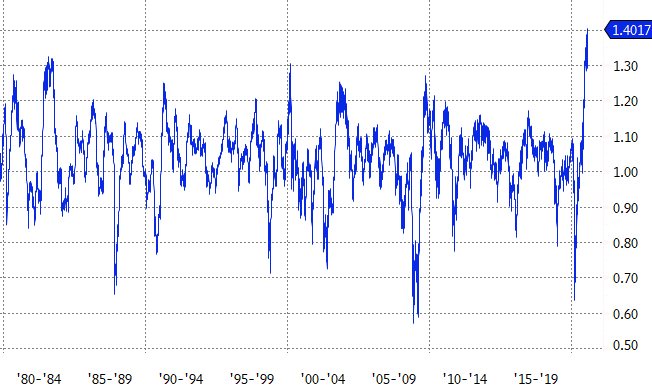The smaller the stock, the bigger the gains. That has been a prevailing theme of 2021 with investors embracing risk wholeheartedly, sending shares of small companies to dizzying heights during the first six weeks of the year.
Headlining the massive returns has been the ETFs exposed to the Russell 2000, the largest being the $2bn Xtrackers Russell 2000 UCITS ETF (XRSG) which has surged 13.9% so far this year, as at 12 February. That is nearly four times the return of the S&P 500 which is up 3.8% over the same period.
Now, 13.9% would be an impressive return for any full year, let alone just a six-week period. And just to be clear, this year’s rally did not start from a low level – the Russell 2000 ended 2020 at an all-time high after jumping 20% in the year of COVID-19.
The gains on top of already-hefty gains have pushed the small cap index into the stratosphere, with the Russell 2000 now trading a whopping 40% above its 200-day moving average (DMA) – the biggest gap in the four-decade history of the index.
Also joining in on the act has been the $1.1bn iShares MSCI USA Small Cap UCITS ETF (CUSS) which has returned 13.7% year-to-date.
Small caps are known for being riskier and more volatile than their larger counterparts, and in 2021 so far, that risk has paid off in the form of handsome rewards.
Russell 2000 trades 40% above its 200 DMA

Source: ETF.com
Momentum trade
The parabolic moves in small cap stocks this year are stunning, but perhaps not a total surprise in the context of the current market environment. From GameStop to Hertz to Signal Advance, many small stocks have skyrocketed for no fundamental reason over the past several months.
These moves go hand in hand with the flood of retail traders entering the market through commission-free brokerages such as Robinhood. Many of these traders have been piling into the most volatile stocks; in many cases, those are the stocks held in small cap ETFs.
Retail traders may not be the sole reason for the ascent in small cap stocks. There are fundamental factors that can be pointed to in explaining the rally. Low rates, fiscal/monetary stimulus and a growing supply of COVID-19 vaccines are some of the most cited explanations.
Is the size factor broken? No, it never existed in the first place
But these factors were already well-known at the start of the year suggesting that momentum rather than new fundamental developments is more likely the driver of this year’s rise in small caps.
Small caps balloon
Interestingly, some of the stocks within the aforementioned XRSG have rallied so much that they can hardly be considered small cap stocks anymore.
The small cap ETF’s top holding is Plug Power, with a $34bn market cap. Novavax, Penn National Gaming and Caesars Entertainment follow, each with market capitalisations in excess of $16bn.
By comparison, Campbell Soup and Cboe Global Markets, two S&P 500 constituents, have market values of $14 billion and $10 billion, respectively.
These aberrations are due to a highly unusual market environment in which certain stocks have climbed so rapidly in such a short period of time that the indices have been unable to adjust.
Highlighting this, Plug Power has risen 1,881% since the start of last year, a move that is seldom seen in normal years, but one that hardly raises an eyebrow in today’s manic market.
Can these rapid advances continue at their current pace? Probably not, history suggests. But for now, investors in small cap ETFs can flex their strong returns.
This story was originally published on ETF.com





